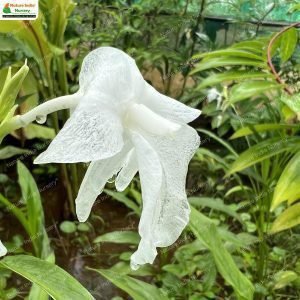Zingiber officinale, commonly known as Ginger, is a flowering plant native to Southeast Asia, with a long history of use as both a spice and in traditional medicine. It belongs to the Zingiberaceae family, which also includes other aromatic plants like turmeric and cardamom. The plant has narrow, lance-shaped leaves and produces yellow-green flowers with purple markings. The most widely used part of the plant is its rhizome (underground stem), which is aromatic, spicy, and pungent in flavor.
Ginger is widely recognized for its culinary use, particularly in cooking, baking, and beverages. It is commonly used in both savory and sweet dishes and is an essential ingredient in many Asian, Indian, and Western cuisines. Additionally, it is used in drinks like ginger tea, ginger ale, and as a flavoring in candies and sweets.
Beyond its culinary uses, Zingiber officinale has been used for thousands of years in traditional medicine, especially in Chinese and Ayurvedic practices. It is known for its digestive, anti-inflammatory, and antioxidant properties.
Habitat
Zingiber officinale thrives in tropical and subtropical climates, preferring warm, humid conditions and well-drained, fertile soil. It is usually grown in areas with abundant rainfall, such as Southeast Asia, India, and parts of Africa and the Caribbean. Ginger is cultivated in gardens, greenhouses, and commercial fields, and it requires partial to full sunlight for optimal growth.
Planting and Care
-
Light: Prefers partial shade to full sun. It thrives in areas that receive indirect sunlight, as direct exposure can scorch the leaves.
-
Soil: Ginger grows best in rich, well-drained, loamy soil that is slightly acidic to neutral (pH 6-7).
-
Watering: Requires consistent moisture, especially during the growing season. However, the soil should not be waterlogged, as excessive moisture can lead to root rot.
-
Maintenance: Ginger plants are relatively low-maintenance but need to be grown in an area where they can receive adequate moisture and warmth. The rhizomes can be harvested after 8 to 10 months of growth. They can be replanted to produce new plants, or fresh rhizomes can be used directly.
Additional Information
-
Zingiber officinale has a long history in traditional medicine. It is widely used to aid digestion, relieve nausea, and reduce symptoms of indigestion and bloating. Ginger is also known for its anti-inflammatory effects and is commonly used to alleviate symptoms of arthritis and muscle pain.
-
The active compound in ginger, gingerol, is responsible for much of its medicinal properties, including its ability to reduce inflammation and provide antioxidant protection.
-
Ginger is also used in many herbal teas, as it is believed to help with colds, flu, sore throats, and respiratory issues. Its warming properties are often associated with improving circulation and boosting immunity.
-
Ginger can be consumed fresh, dried, powdered, or in extract form. It is available in many forms, including as a spice, in supplements, and in tea.
Note: While generally considered safe for most people when consumed in moderation, ginger can interact with certain medications and may cause side effects such as heartburn or digestive discomfort in sensitive individuals. It is advisable to consult with a healthcare provider before using ginger medicinally, especially if you are pregnant, nursing, or on medication.




